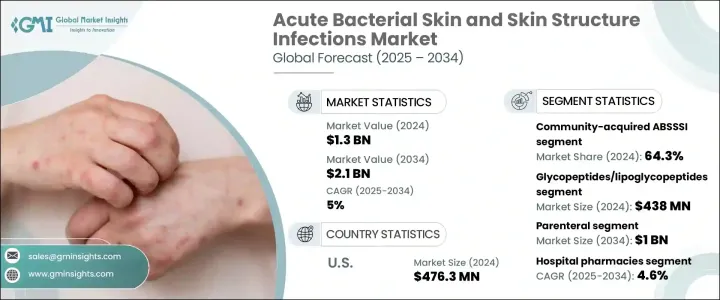
세계 급성 세균성 피부 및 피부 구조 감염증 시장은 2024년 13억 달러 규모에 달했으며, 2025년부터 2034년까지 연평균 5%의 성장률을 보일 것으로 예측됩니다. 이 시장은 내성균의 증가, 피부 및 연조직 감염의 유병률 증가, 항생제 제제 및 전달 방법의 급속한 발전 등을 배경으로 꾸준히 성장할 것으로 예상됩니다. 화학요법 및 장기 이식 환자를 포함한 면역부전 환자의 증가는 효과적인 치료 옵션에 대한 수요 증가에 기여하고 있습니다. 당뇨병, 말초혈관질환 등 복잡한 피부 감염에 취약한 만성질환이 급증하면서 시장 확대에 더욱 박차를 가하고 있습니다.

또한, 피부 감염의 조기 진단 및 치료에 대한 인식이 높아지고 내성 병원체를 표적으로 하는 혁신적인 치료법 개발이 시장 전망을 크게 형성하고 있습니다. 제약사들은 전 세계적으로 큰 문제가 되고 있는 MRSA(메티실린 내성 황색포도상구균)와 같은 다제내성균에 대응할 수 있는 새로운 항생제를 출시하기 위해 연구개발에 많은 투자를 하고 있습니다. 이를 위해 내성균을 표적으로 작용하는 글리코펩타이드계, 옥사졸리디논계, 리포펩타이드계 등 보다 고도화된 항생제 도입이 진행되어 환자의 예후를 개선하고 치료 성공률을 높이고 있습니다.
| 시장 범위 | |
|---|---|
| 시작 연도 | 2024년 |
| 예측 연도 | 2025-2034년 |
| 시작 금액 | 13억 달러 |
| 예상 금액 | 21억 달러 |
| CAGR | 5% |
이 시장은 감염증의 종류에 따라 시중감염형 ABSSSI와 병원내 감염형 ABSSSI의 두 가지로 분류됩니다. 병원내 감염은 일반 인구에서 훨씬 더 많이 발생하며, 병원 외의 환경에서도 발생하는 경우가 많기 때문에 2024년 점유율은 병원내 감염이 64.3%를 차지했습니다. 봉와직염, 상처 감염, 농양 등의 질병이 연간 환자 수에 크게 기여하고 있습니다. 이러한 감염성 질환은 종종 의료적 개입이 필요하지만, 보통 외래에서 관리되기 때문에 효과적이고 투여하기 쉬운 항생제 치료에 대한 수요가 지속적으로 발생하고 있습니다. 생활습관병으로 인한 피부 손상과 피부 무결성 감소의 발생률이 증가함에 따라, 시중 감염 분야는 ABSSSI 시장의 괄목할 만한 성장을 계속 주도하고 있습니다.
약물 투여 경로에 따라 시장은 비경구제, 경구제, 국소제로 분류됩니다. 비경구제 부문은 2034년까지 10억 달러 규모의 시장을 창출할 것으로 예상되며, 특히 중증 및 복합 질환에서 항생제 투여를 위한 선호되는 경로로 자리 잡고 있습니다. 항생제를 혈류로 직접 투여하는 비경구 투여는 다제내성 병원균으로 인한 생명을 위협하는 ABSSSI 치료에 여전히 필수적입니다. 비경구 투여는 신속한 치료를 가능하게 하며, 특히 병원내 감염이나 중환자실 환자들에게 필수적입니다.
미국의 급성 세균성 피부 및 피부 구조 감염(ABSSSI) 시장은 2024년 4억 7,630만 달러로 평가되었습니다. 이는 피부 감염의 높은 발생률과 ABSSSI 발병 위험을 높이는 당뇨병 및 비만과 같은 만성질환의 증가가 주요 요인으로 작용하고 있습니다. 고령화 사회는 면역 방어력 저하로 인해 피부 감염에 취약하여 시장 역학에 지속적으로 영향을 미치고 있습니다. 또한, 다제내성균, 특히 MRSA의 지속적인 도전은 첨단 차세대 항생제 요법에 대한 수요를 뒷받침하며 미국의 지속적인 시장 성장을 뒷받침하고 있습니다.
The Global Acute Bacterial Skin and Skin Structure Infections Market reached USD 1.3 billion in 2024 and is projected to expand at a CAGR of 5% between 2025 and 2034. The market is poised for steady growth, driven by rising bacterial resistance, the increasing prevalence of skin and soft tissue infections, and rapid advancements in antibiotic formulations and delivery methods. A growing number of immunocompromised individuals, including patients undergoing chemotherapy or organ transplantation, are contributing to the escalating demand for effective treatment options. The surge in chronic diseases such as diabetes and peripheral vascular disorders, which make patients more susceptible to complicated skin infections, is further supporting market expansion.

Additionally, growing awareness regarding early diagnosis and treatment of skin infections, coupled with the development of innovative therapies targeting resistant pathogens, is significantly shaping the market outlook. Pharmaceutical companies are investing heavily in research and development to launch novel antibiotics capable of tackling multidrug-resistant organisms like MRSA (Methicillin-resistant Staphylococcus aureus), which remains a major concern globally. This has led to the introduction of more advanced antibiotics, including glycopeptides, oxazolidinones, and lipopeptides, that offer targeted action against resistant bacteria, improving patient outcomes and enhancing treatment success rates.
| Market Scope | |
|---|---|
| Start Year | 2024 |
| Forecast Year | 2025-2034 |
| Start Value | $1.3 Billion |
| Forecast Value | $2.1 Billion |
| CAGR | 5% |
The market is segmented into two primary categories based on infection type: community-acquired and hospital-acquired ABSSSIs. Community-acquired infections accounted for a dominant 64.3% share in 2024, as these infections are far more prevalent in the general population and often occur outside hospital environments. Conditions such as cellulitis, wound infections, and abscesses contribute significantly to the number of cases seen annually. These infections frequently require medical intervention but are typically managed in outpatient settings, creating sustained demand for effective and easily administrable antibiotic therapies. With the rising incidence of skin injuries and compromised skin integrity due to lifestyle diseases, the community-acquired segment continues to drive notable growth in the ABSSSIs market.
Based on drug administration routes, the market is classified into parenteral, oral, and topical formulations. The parenteral segment is projected to generate USD 1 billion by 2034, maintaining its stronghold as the preferred route for delivering antibiotics, especially in severe and complicated cases. Parenteral administration, which delivers antibiotics directly into the bloodstream, remains critical for treating life-threatening ABSSSIs caused by multidrug-resistant pathogens. It enables rapid therapeutic action and is especially vital for hospital-acquired infections and patients in intensive care units, where timely intervention is crucial to avoid systemic complications.
The U.S. Acute Bacterial Skin and Skin Structure Infections (ABSSSIs) market was valued at USD 476.3 million in 2024, largely driven by the high incidence of skin infections and rising chronic health conditions, including diabetes and obesity, which elevate the risk of developing ABSSSIs. An aging population, more prone to skin infections due to weakened immune defenses, continues to influence market dynamics. Moreover, the persistent challenge posed by multidrug-resistant bacteria, particularly MRSA, sustains the demand for advanced, next-generation antibiotic therapies and supports continued market growth in the U.S.